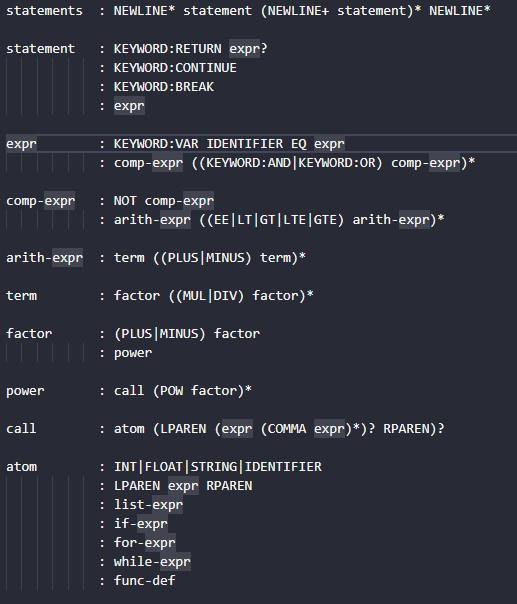
6 minute read
Compiler Design Using Context-Free Grammar
Arpit Patil, Saloni Khedekar, Omkar Vyavhare, Rahul Dound
Abstract
Advertisement
Compiler design is a crucial aspect of computer science, as it enables the translation of high-level programming languages into machine-readable code. One approach to compiler design is to use context-free grammars (CFGs) to specify the syntax of a programming language. In this researchpaper,wewillexploretheuseofCFGsincompiler design and their benefits and limitations. We will first provide an overview of CFGs and their role in compiler design, includinga descriptionof theformal definitionof a CFG and the processes involved in creating a CFG for a programming language. Additionally, we will examine the challenges and limitations of using CFGs in compiler design, including issues of ambiguity and efficiency, and discusspotentialsolutionsandalternatives.
Keywords
CompilerDesign,Context-FreeGrammar,Python,Lexing, Parsing.
1. INTRODUCTION
Compilers are essential tools in the field of computer science, as they allow users to write and execute programsinhigh-levelprogramminglanguages.Inorder to translate these programs into machine code, compilers must be able to accurately parse and understand the syntax and structure of the source language. One key aspect of this process is the use of context-free grammar (CFGs) to define the syntax of programming languages. CFGs are a formal way of specifying the syntactic structure of a language, using a setofrulesandsymbolstodefinetheallowedsequences oftokens(suchaskeywords,variables,andoperators)in a program. These grammars can be used to generate parsetrees,whichrepresentthehierarchicalstructureof a program and can be used to check its syntax and semantics. In this research paper, we will delve into the role of CFGs in compiler design and discuss the various techniques and algorithms that are used to implement them.Wewillalsoexplorethechallengesandlimitations of using CFGs in compiler design, including issues of ambiguity and efficiency,anddiscusspotential solutions and alternatives examining the role of CFGs in compiler design,weaimtoprovideabetterunderstandingofhow thesetoolsworkandhowtheycanbeusedtoeffectively parseandunderstandprogramminglanguages.
2. LITERATURE REVIEW
NoamChomsky[1]madesignificantcontributionstothe fieldofformallanguagesandtheconceptof context-free grammar (CFGs). His work laid the foundation for the use of CFGs in compiler design and other areas of computer science. Chomsky's work on CFGs has had a significantimpactonthefieldofcompilerdesign,asthey provide a formal way of specifying the syntactic structure of a language. Many compiler design techniques and algorithms, such as top-down and bottom-up parsing, are based on the use of CFGs to generateparsetreesandcheckthesyntaxandsemantics ofprograms.
AlfredAhoandJeffreyUllman[2]intheirbook,providea thoroughoverviewoftheuseofCFGsincompilerdesign, includingthevarioustechniquesandalgorithmsthatare usedtoimplementthem.TheroleofCFGsindefiningthe syntaxofprogramminglanguagesandtheimportanceof generatingaccurateparsetreestocheckprogramsyntax and semantics. Aho and Ullman also address the challenges and limitations of using CFGs in compiler design, including issues of ambiguity and efficiency. The solutions to these challenges, such as using disambiguation rules and incorporating additional formalisms, such as attribute grammar, to improve the expressivenessandprecisionofCFGs.
Steven Johnson[3] is known for his work on the developmentoftheYaccparsergenerator,whichisused to automatically generate parsers from context-free grammars (CFGs). Yacc, which stands for "Yet Another Compiler Compiler," is a widely used tool in compiler design and has been influential in the development of many programming languages. Johnson's work on Yacc has had a significant impact on the field of compiler design, as it provides a convenient and efficient way of implementing CFGs in compiler design. Using Yacc, programmers can specify the syntax of a programming language using a CFG and then automatically generate a parser that can check the syntax and semantics of programswritteninthatlanguage.
Andrew Appel [4] who is known for his work on the developmentoftheTigerprogramminglanguageandthe accompanyingcompiler,whichwasusedasa casestudy todemonstratetheuseofcontext-freegrammars(CFGs) in compiler design. In his work on the Tiger compiler, AppeldemonstratedhowCFGscanbeusedtoeffectively define the syntax of a programming language and generateparsetreesthatcanbeusedtocheckthesyntax
International Research Journal of Engineering and Technology (IRJET) e-ISSN:2395-0056
Volume: 10 Issue: 01 | Jan 2023 www.irjet.net p-ISSN:2395-0072 and semantics of programs written in that language. He also addressed the challenges and limitations of using CFGs in compiler design, including issues of ambiguity and efficiency, and discussed potential solutions and alternatives.
Frank DeRemer and Tom Pennello [5] are computer scientists who are known for their work on bottom-up parsing and the development of the LL(k) and LR(k) parsing algorithms, which are widely used in compiler design. Bottom-up parsing involves constructing a parse tree from the leaves and expanding it towards the root, using the rules of context-free grammar rules the input program into its underlying syntactic structure. The LL(k)andLR(k)algorithmsaretwocommontechniques for implementing bottom-up parsing and have been widely used in compiler design due to their ability to handle left recursion and efficiently parse large programs.
3. METHODOLOGY
Forthisproject,Pythonisusedtodesignacompilerand our own programming language. To design our own programming language and compiler following techniquesareused:
1. Lexical analysis: This is the process of breaking the source code into a sequence of tokens, which are the basicunitsoftheprogramminglanguage.
2. Syntax analysis: This is the process of checking the sourcecodeforcorrectsyntax,usinggrammarrules
3. Semantic analysis: This is the process of checking the source code for meaning and ensuring that it is semanticallycorrect.
4. Intermediate code generation: This is the process of generating an intermediate representation of the source code,whichiseasierforthecompilertoworkwith.
5. Code optimization: This is the process of improving the efficiency of the generated code by making it run fasterorusefewerresources.
6. Code generation: This is the process of generating machine code from the intermediate representation of thesourcecode.
3.1 Proposed System
This Compiler design using a Context-Free Grammar project helps to create a custom programming language usingourownsetofrulesandsyntax.Wehavedeclared our own Context Free Grammar i.e. our own set of rules and have developed our own compiler to compile that programminglanguageanddisplaythedesiredoutput.
Overall, the process of a compiler is breaking down the input program into its individual tokens, generating a parsetreetorepresentthesyntaxoftheprogram,check the semantics of the program, generating machine code, andassemblingthemachinecodeintoaformthatcanbe executed. These steps are typically carried out by different components of the compiler, such as the lexer, parser, semantic analyzer, code generator, and assembler.
Stepsindesigningthecompilerandlanguage:
Step1: Define the syntax and semantics of the programming language: This will involve deciding on the structure and rules of the language, including the types of variables, operators,andcontrolstructuresitwillsupport.
Step2: Implementthelexer:tobreakdowntheinputin a sequence of tokens by writing code that can match the various tokens in the language and definefunctionstohandlethelexingprocess.
Step3: Implementtheparser:Theparserisresponsible for generating a parse tree from the input program, using the rules of the CFG defined in stepI.Weusedaparsingalgorithm,suchastopdown or bottom-up parsing, to construct the parse tree. To implement the parser, we write code that can apply the rules of the CFG to the inputprogramandgeneratetheparsetree.
Step4: Implementthesemanticanalyzer:Thesemantic analyzer is responsible for checking the semantics of the program, including verifying the types of variables and ensuring that the program follows the rules of the language. To implement the semantic analyzer, we write a code that can check the semantics of the programandreportanyerrorsthatarefound.
Step5: Implement the code generator: The code generator is responsible for translating the parse tree into machine code that can be executed by the computer. To implement the codegenerator, wewritecodethatcan traverse the parse tree and generate the corresponding machinecode.
Step6: Test and debug your compiler: Once we have implemented the various components of our compiler,itwill beimportanttothoroughlytest it to ensure that it is functioning correctly and producing the desired output. For that, wehave debugged our compiler to fix any issues that arise.
Fig 1. Flowchart of the project
4. RESULTS AND DISCUSSIONS
Alltheaboveprocessisusedindesigningthislanguage’s grammarandcompiler.
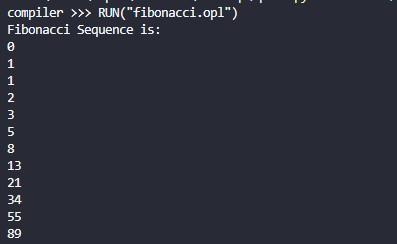
The user needs to first create a file with the program as perthegivensyntaxandrules.Thenneedtosaveitwith the .opl extension the user needs to start the compiler andenterthecommandRUN(“filename.opl”).
After doing this, if the syntax and rules are correct then thedesiredoutputwillgetdisplayed.
Fig 2. Program to print Fibonacci series
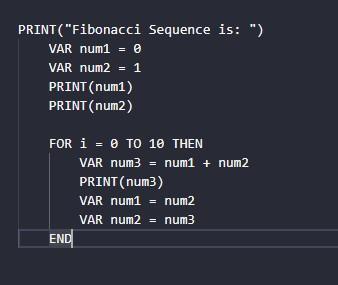
Fig 3 The output of the program
Fig 4. Grammar of the programming language
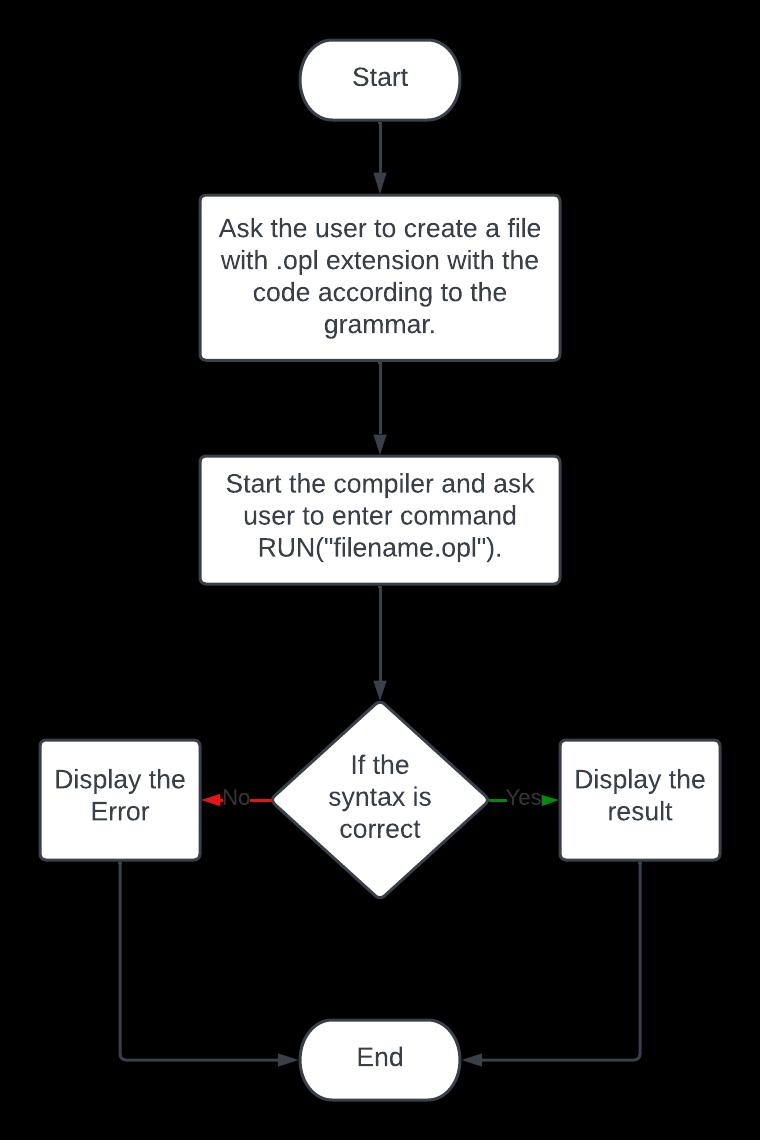
Fig 5. Grammar of the language
5. LIMITATIONS
• Only Limited programs can be implemented usingthislanguage.
• Ambiguity: Context-free grammar is sometimesambiguous,whichmeansthatthey allow multiple parse trees to be constructed for the same input string. This can lead to difficulty in determining the intended meaning of the input and can make it harder togeneratethecorrectcode.
6. Conclusion
In this project, we understood that there are many different approaches to compiler design, and contextfree grammars play a central role in many of them. By using context-free grammar to define the structure of a programminglanguage,compilerscanparseandanalyze the source code to ensure that it is syntactically correct andsemanticallymeaningful.Thisisacriticalstepinthe compilation process, as it enables the compiler to generate efficient machinecode thatcan be executed by thecomputer.
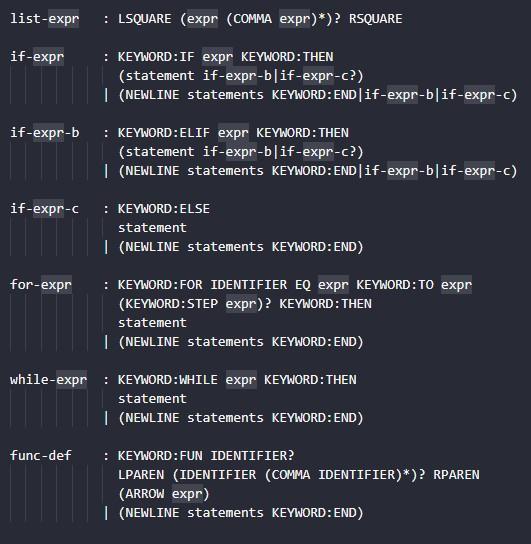
7. Future Scope
Improved parsing algorithms: Currently, most compilers use variations of the top-down or bottom-upparsingalgorithms.However,thereis room for improvement in these algorithms, as well as the development of new parsing algorithmsthataremoreefficientandeffective.
Language extensions: As programming languagescontinuetoevolve,thereisaneedfor compilers that can handle new language constructs and features. Research in this area could focus on extending context-free grammar tosupportthesenewlanguagefeatures.
8. References
[1] Kuldeep Vayadande, Aditya Bodhankar, Ainkya Mahajan, Diksha Prasad, Shivani Mahajan, Aishwarya Pujari and Riya Dhakalkar, “Classification of Depression on social media using Distant Supervision”, ITM Web Conf. Volume50,2022
[2] Kuldeep Vayadande,Rahebar Shaikh, Suraj Rothe, Sangam Patil,Tanuj BawareandSameer Naik,” Blockchain-Based Land Record SysteM”, ITMWebConf.Volume50,2022.
[3] Kuldeep Vayadande,Kirti Agarwal,Aadesh Kabra,Ketan GangwalandAtharv Kinage,” Cryptography using Automata Theory”, ITM WebConf.Volume50,2022
[4] Samruddhi Mumbare, Kunal Shivam, Priyanka Lokhande, Samruddhi Zaware, Varad DeshpandeandKuldeep Vayadande,”Software ControllerusingHandGestures”,ITMWebConf. Volume50,2022
[5] Preetham,H.D.,andKuldeepBabanVayadande. "Online Crime Reporting System Using Python Django."
[6] Vayadande, Kuldeep B., et al. "Simulation and Testing of Deterministic Finite Automata Machine." International Journal of Computer SciencesandEngineering 10.1(2022):13-17.
[7] Vayadande, Kuldeep, et al. "Modulo Calculator Using Tkinter Library." EasyChair Preprint 7578 (2022).
[8] VAYADANDEKULDEEP.“SimulatingDerivations ofContext-FreeGrammar”(2022).
[9] Vayadande, Kuldeep, Ram Mandhana, Kaustubh Paralkar, Dhananjay Pawal, Siddhant Deshpande, and Vishal Sonkusale. "Pattern Matching in File System." International Journal ofComputerApplications 975:8887.

